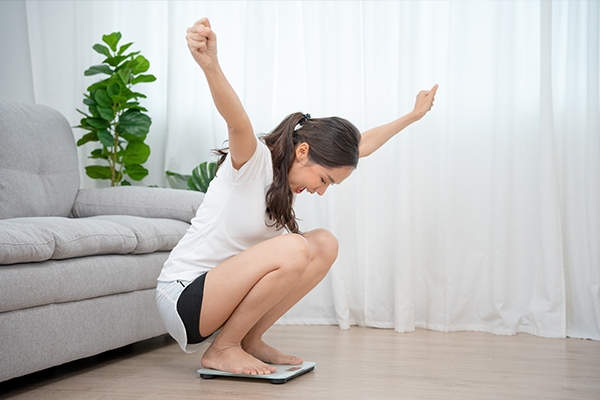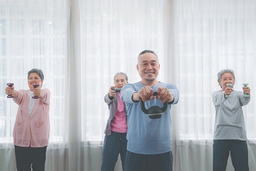Simple Steps to a Fitter Body

Are you a member of the "kaum rebahan" (layover club)? Be cautious. Laziness may weaken the immune system and lead to a variety of chronic disorders. An inactive individual also takes longer to recover from illness than an active one.
Now, do the math! How much time do we spend sitting during the course of a day (24 hours)? We sit at work or school. Go back home; we're stuck in traffic, sitting. At home, either watching Netflix or playing video games, we're sitting.

What about the weekend? Instead of exercising, having breakfast or lunch at our favorite restaurant sounds better. And, yeah, we sit. We do the same thing when we go to the movies: we sit.
Most people spend most of their time sitting. Yes, we can save more energy while sitting, but we also need to take at least 30 minutes to stand and do a small exercise throughout the day.
The more we sit, the more glucose is stored in our body because it does not transform it into energy. When sugar levels rise, diabetes lurks. Long-term inactivity also weakens muscles, making us struggle with sore joints.
Meanwhile, being physically active can help improve mental health and cognitive performance. How so? You may imagine how difficult it is to devote time to exercise. There's no need to be concerned.
Being physically active does not automatically imply being a terrific runner or swimmer. Enough with light activities like park walks, riding, swimming, or even gardening. The most important thing is to be active and to do so consistently.
Get moving!

There are numerous ways to stay active during the day. Get up and move around whenever you realize you've been sitting for an extended period of time. Exactly like that. Repeat.
- Do it slowly. If you feel like you haven't moved much, conduct light activities gently, like a warm-up, to avoid injuring your bones or joints. Begin with a short duration, such as 5–10 minutes. Increase the duration gradually.
- Get your 30. Every day, engage in at least 30 minutes of physical activity. You can divide it into 10 minutes for a greater health benefit than if you did it all in one extended session. For example, walk 10 minutes to work, 10 minutes for lunch, and 10 minutes back home. It's perfectly fine if you wish to do it for an extended period of time. However, exercising less allows you to do it again the following day.
- Muscle up. Aerobic exercise is advantageous, but resistance or weightlifting workouts are also helpful. This form of exercise can help strengthen muscles and bones, improve balance and coordination, and lower the risk of osteoporosis. Muscle strength keeps you from getting wounded or falling.
- Stretching. Stretching after exercise should be part of your daily practice. Stretching helps to improve flexibility and range of motion. Reduces the likelihood of injury or muscular cramping. Stretching also increases circulation throughout the body.
- Staying active. Staying active is an essential component of living a healthy life. You don't have to go to the gym every day, but get creative to get your 30 minutes of action done. You can move around while listening to the news, walk to the shop, or go for a brief walk after supper. That's it!
The advantages of staying active

1. Immediate advantages
The benefits of a moving routine begin immediately following a physical activity session. Physical activity can improve cognitive performance in youngsters aged 6 to 13 years. Meanwhile, in adults, this activity can aid with anxiety and sleep.
2. Maintain your weight
Diet and regular physical activity are crucial in weight management. It is easy to gain weight when you consume more calories than you burn, especially during physical activity.
Do 150 minutes of moderate physical activity every week to keep your weight stable. You can share it by undertaking activities for 30 minutes a day, five days a week. However, keep in mind that the amount of physical activity required to maintain a healthy weight differs from person to person. Maintain a healthy diet as well.
3. Reducing the risk of certain diseases
- Cardiovascular disease
A person who engages in moderate physical exercise for at least 150 minutes per week has a lower risk of heart disease and stroke. Regular physical activity can help decrease blood pressure and cholesterol levels.
- Type 2 diabetes and metabolic syndrome
Regular physical exercise lowers the incidence of type 2 diabetes and metabolic syndrome, both of which are linked to a variety of health concerns.
- Some cancers
Physical activity reduces the risk of acquiring cancers of the bladder, colon (proximal and distal), endometrial, esophagus (adenocarcinoma), kidney, lung, and stomach (cardia and noncardiac adenocarcinoma).
If you are a cancer survivor, frequent physical activity not only improves your quality of life but also your physical fitness.
4. Strengthens bones and muscles
It is critical to safeguard your bones, joints, and muscles as you age because they support your body and allow you to move. Keeping your bones, joints, and muscles healthy enables you to carry out daily activities and be physically active.
So, do you still want to be lazy? Keep active and keep moving for a long and healthy life.
Click on WhatsApp if you want to learn more about active living or visit GWS Medika Clinic, health clinic in Jakarta.



